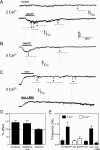P2X7 receptors trigger ATP exocytosis and modify secretory vesicle dynamics in neuroblastoma cells
- PMID: 21292765
- PMCID: PMC3064193
- DOI: 10.1074/jbc.M110.139410
P2X7 receptors trigger ATP exocytosis and modify secretory vesicle dynamics in neuroblastoma cells
Abstract
Previously, we reported that purinergic ionotropic P2X7 receptors negatively regulate neurite formation in Neuro-2a (N2a) mouse neuroblastoma cells through a Ca(2+)/calmodulin-dependent kinase II-related mechanism. In the present study we used this cell line to investigate a parallel though faster P2X7 receptor-mediated signaling pathway, namely Ca(2+)-regulated exocytosis. Selective activation of P2X7 receptors evoked exocytosis as assayed by high resolution membrane capacitance measurements. Using dual-wavelength total internal reflection microscopy, we have observed both the increase in near-membrane Ca(2+) concentration and the exocytosis of fluorescently labeled vesicles in response to P2X7 receptor stimulation. Moreover, activation of P2X7 receptors also affects vesicle motion in the vertical and horizontal directions, thus, involving this receptor type in the control of early steps (docking and priming) of the secretory pathway. Immunocytochemical and RT-PCR experiments evidenced that N2a cells express the three neuronal SNAREs as well as vesicular nucleotide and monoamine (VMAT-1 and VMAT-2) transporters. Biochemical measurements indicated that ionomycin induced a significant release of ATP from N2a cells. Finally, P2X7 receptor stimulation and ionomycin increased the incidence of small transient inward currents, reminiscent of postsynaptic quantal events observed at synapses. Small transient inward currents were dependent on extracellular Ca(2+) and were abolished by Brilliant Blue G, suggesting they were mediated by P2X7 receptors. Altogether, these results suggest the existence of a positive feedback mechanism mediated by P2X7 receptor-stimulated exocytotic release of ATP that would act on P2X7 receptors on the same or neighbor cells to further stimulate its own release and negatively control N2a cell differentiation.
Figures






Similar articles
-
Exocytotic release of ATP from cultured astrocytes.J Biol Chem. 2007 Sep 28;282(39):28749-28758. doi: 10.1074/jbc.M700290200. Epub 2007 Jul 12. J Biol Chem. 2007. PMID: 17627942
-
Functional decreases in P2X7 receptors are associated with retinoic acid-induced neuronal differentiation of Neuro-2a neuroblastoma cells.Cell Signal. 2009 Jun;21(6):881-91. doi: 10.1016/j.cellsig.2009.01.036. Cell Signal. 2009. PMID: 19385050
-
Autocrine activation of P2X7 receptors mediates catecholamine secretion in chromaffin cells.Br J Pharmacol. 2024 Aug;181(16):2905-2922. doi: 10.1111/bph.16371. Epub 2024 Apr 28. Br J Pharmacol. 2024. PMID: 38679932
-
Regulated exocytosis and vesicle trafficking in astrocytes.Ann N Y Acad Sci. 2009 Jan;1152:30-42. doi: 10.1111/j.1749-6632.2008.04005.x. Ann N Y Acad Sci. 2009. PMID: 19161374 Review.
-
Understanding the roles of the P2X7 receptor in solid tumour progression and therapeutic perspectives.Biochim Biophys Acta. 2015 Oct;1848(10 Pt B):2584-602. doi: 10.1016/j.bbamem.2014.10.029. Epub 2014 Nov 14. Biochim Biophys Acta. 2015. PMID: 25450340 Review.
Cited by
-
Role of P2X7 and P2Y2 receptors on α-secretase-dependent APP processing: Control of amyloid plaques formation "in vivo" by P2X7 receptor.Comput Struct Biotechnol J. 2015 Mar 11;13:176-81. doi: 10.1016/j.csbj.2015.02.005. eCollection 2015. Comput Struct Biotechnol J. 2015. PMID: 25848496 Free PMC article. Review.
-
Mechanism of P2X7 receptor-dependent enhancement of neuromuscular transmission in pannexin 1 knockout mice.Purinergic Signal. 2018 Dec;14(4):459-469. doi: 10.1007/s11302-018-9630-7. Epub 2018 Oct 25. Purinergic Signal. 2018. PMID: 30362043 Free PMC article.
-
Extracellular Membrane Vesicles Derived from 143B Osteosarcoma Cells Contain Pro-Osteoclastogenic Cargo: A Novel Communication Mechanism in Osteosarcoma Bone Microenvironment.Transl Oncol. 2014 Jun 17;7(3):331-40. doi: 10.1016/j.tranon.2014.04.011. eCollection 2014 Jun. Transl Oncol. 2014. PMID: 25180057 Free PMC article.
-
P2X7 Receptor Function in Bone-Related Cancer.J Osteoporos. 2012;2012:637863. doi: 10.1155/2012/637863. Epub 2012 Aug 16. J Osteoporos. 2012. PMID: 22970409 Free PMC article.
-
P2X7 in Cancer: From Molecular Mechanisms to Therapeutics.Front Pharmacol. 2020 Jun 4;11:793. doi: 10.3389/fphar.2020.00793. eCollection 2020. Front Pharmacol. 2020. PMID: 32581786 Free PMC article. Review.
References
-
- Burnstock G., Kennedy C. (1985) Gen. Pharmacol. 16, 433–440 - PubMed
-
- von Kügelgen I., Wetter A. (2000) Naunyn-Schmiedebergs Arch. Pharmacol. 362, 310–323 - PubMed
-
- Khakh B. S., Burnstock G., Kennedy C., King B. F., North R. A., Séguéla P., Voigt M., Humphrey P. P. (2001) Pharmacol. Rev. 53, 107–118 - PubMed
-
- North R. A. (2002) Physiol. Rev. 82, 1013–1067 - PubMed
-
- Jarvis M. F., Khakh B. S. (2009) Neuropharmacology 56, 208–215 - PubMed
Publication types
MeSH terms
Substances
LinkOut - more resources
Full Text Sources
Medical
Miscellaneous

